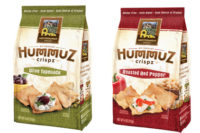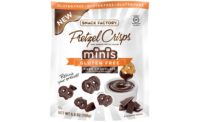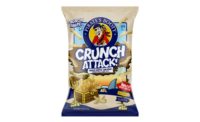Manufacturers of crackers, crisps and puffs are adding nutrients and specialty ingredients to their products, while cutting fat, gluten and more to meet consumer demand for exceptional quality.
Nearly everybody eats salty snacks. According to a new report from market research firm Packaged Facts, 90% of U.S. households reported to “chowing down” on chips, crisps, puffs and cheese snacks in the past 30 days, and very few of these snackers limit themselves to just one product variety. In fact, two out of three American households have at least three kinds of these crave-worthy mainstays in their rotation.
But this in-demand market is experiencing some growing pains, as a subset of what Packaged Facts calls “healthy snackers” wield more and more influence. Out of the 50 million consumers who snack between meals and cite salted snacks as their favorite, the healthy snackers are a powerful army of 14.2 million, Packaged Facts, says, and “usually only snack on healthy foods.” These consumers exercise often and don’t see a conflict between craving a chip (an option traditionally landing in the unhealthy camp) and pursuing a healthy snacking diet.
“The market for crackers and chips is growing as consumers snack more and have fewer organized meals,” explained Cara Figgins, executive vice president of Partners, a Tasteful Choice Co., Seattle. “However, consumers are no longer looking for just a cracker or a chip. They are looking for healthier options with more interesting ingredients and flavor profiles.”
Indeed, according to Steve Sklar, senior vice president and general manager for Inventure Foods Inc., Phoenix, the on-the-go lifestyle of today’s American family keeps them coming back time and time again for snacks, and as a result, he says, snacking is more popular today than it’s ever been. “It’s not been without challenges, however, as snack manufacturers have had to evolve to meet new consumer interests in better-for-you, natural ingredients,” he cautions. “I do believe the industry has responded well overall, so in terms of the state of the industry, I’d say the snack food category is a healthy segment in terms of sales, and it’s getting even healthier as it relates to ingredients, nutrition and variety.”
Healthier profiles
When consumers scrutinize nutritional facts, they’re often looking for added value. In the snack aisle, that value comes in the form of healthy ingredients and nutritional content to boost existing formulations or replace less-desired ingredients.
In March, Wheat Thins from Nabisco, East Hanover, NJ, a subsidiary of Mondelez International, launched a whole-grain product with its Wheat Thins Popped line, available in Sea Salt, Sour Cream and Onion, and Spicy Cheddar flavors. The product delivers 10 g. of whole grains per every 30-g. serving. It’s also a low-calorie option, clocking in at just 130 calories for a 26-chip serving.
Triscuit, also from Nabisco, recently reimagined its crackers when it launched Brown Rice Triscuit last August. The baked line is made with brown rice, sweet potato and red bean, and in March, expanded to include Brown Rice Triscuit Thin Crisps in Sour Cream and Chive, Wasabi and Soy and Cinnamon Sugar varieties.
But for some consumers, whole grain isn’t enough—they want the ever-exotic ancient grains. The category of ancient grains includes trend-topping mainstays like quinoa and chia, but also lesser known varieties like amaranth, teff, spelt, millet, kamut and others. Ancient grains are in demand because they generally pack a more powerful nutritional punch than their conventional counterparts, with higher fiber and mineral content.
Partners launched Free for All Kitchen, a gluten-free, ancient grain and cassava flour cracker, in November. “It’s a great alternative to the other gluten-free crackers on the market because it’s made without corn, rice or soy,” notes Figgins. Free for All Kitchen crackers are nonGMO and available in the company’s three top-selling flavors: Olive Oil and Sea Salt; Roasted Garlic and Rosemary; and Olive Oil and Herb.
“As food manufacturers, the biggest challenge for us is to make sure we keep up with what the consumer needs and expects,” she adds. “Consumers want to know what is in the food they eat, they want it to taste good, and they want it to add value to their lives by providing nutrition and making their lives easier.”
B&G Foods Inc., Parsippany, NJ, is also tapping into consumers’ desire for ancient grains with Old London Ancient Grains Melba Toasts. “These are twice-baked toasts, perfect for easy appetizers, snacks and mini-meals,” says executive vice president of snacks, Michael Sands. Old London Ancient Grains Melba Toasts have 60 calories per serving and boast a variety of ancient grains like millet, amaranth, buckwheat and quinoa.
“We have seen a number of grains trending this year, particularly in the salty snack category,” notes Sklar. “Sorghum, teff and amaranth, in particular, are growing in popularity.”
Inventure Foods’ Boulder Canyon brand launched Boulder Canyon Ancient Grains snack chips in May, which offer a blend of sorghum, teff, amaranth, quinoa, millet, chia and brown rice. “It makes for a hearty chip and an abundance of flavor,” Sklar adds. “We didn’t want to overcomplicate this unique blend with heavy-handed seasoning, so we use a touch of sea salt, a bit of garlic and a dash of red pepper. Early signs show this recipe is a winner.”
Protein power
Once relegated to the sports nutrition or bar aisle, protein is another value-added item making a splash in the snack market. Inventure Foods launched Boulder Protein Crisps in two flavors—Dark Chocolate and Asiago Cheese—in March. These crisps boast 10 g.
of plant-based protein per serving and are minimally processed. “They will successfully bridge the gap between functional foods and great tasting snacks,” Sklar points out.
Kitchen Table Bakers, Syosset, NY, also prides itself on offering a high-protein product for discerning consumers. Its Parmesan Crisps are baked entirely of aged parmesan cheese and are naturally free of gluten, wheat and sugar. As such, they fit into a number of specialty diets from Paleo and gluten-free to Atkins and low-glycemic, observes the company’s founder and president, Barry Novick. “We are continuing to see growing interest from consumers looking for snacking options that are low in carbohydrates, but still high in protein,” he explains. “More consumers want options they can bring on-the-go that will curb cravings, but won’t leave them feeling guilty for snacking.”
What a snack doesn’t contain
Just as manufacturers are discovering how important it is to add healthy ingredients to their products, they’re finding just as much success with what they’re taking out of them, namely, gluten and “bad” fats.
Gluten-free continues to dominate the snack aisle, as the once-specialty diet expands beyond celiac disease patients to include consumers simply seeking what they perceive to be a healthier diet. “One of the biggest obstacles facing the category continues to be awareness and education as it pertains to healthier snacking (like nonGMO and gluten-free),” explains Dani Dahlberg, marketing manager for TH Foods and the Crunchmaster brand, Loves Park, IL. “Many consumers have family or friends that are affected by celiac disease or gluten intolerance. However, they’re not [always] aware of exactly what that means for their diet choices and on how to avoid gluten—especially hidden sources—in their diets.”
The company’s Popped Edamame Chips, launched in the fall of 2013, and are available in Sea Salt and Wasabi Soy varieties. They are certified gluten-free, nonGMO and are made with a blend of California rice and edamame. They’re also free of saturated fat and cholesterol, and boast 3 g. of protein per 18-chip serving.
B&G Foods recently rolled out gluten-free Pirate’s Booty Crunchy Treasures, a snack made from puffed rice and corn, blended with real aged white cheddar cheese. The snack is school lunch-friendly in that it’s also peanut- and tree nut-free, and features three pirate-themed shapes: Crunchy parrots; “X” marks the spots; and pirate ship wheels. Pirate’s Booty Fruity Booty, a puffed rice and corn snack, coated in real berry, is also gluten- and nut-free.
“Today’s snack consumer is an educated one,” says Sands. “The first thing they do is flip over the package to see how the nutritionals stack up.” Shoppers flipping over B&G Foods’ packaging won’t be confused—the company recently started highlighting product attributes like gluten-free, baked, and protein and fiber content right on the front of the package. “Consumers are getting smarter and faster every day, with unlimited access to nutritional and ingredient information at their fingertips,” adds Sands, “so we make it our mission to stay ahead of ingredient trends, make our products highly shoppable and develop portable packaging formats to fit consumers’ fast-paced lifestyles.”
The key for cracker, crisp and puff manufacturers is keeping their ears open for trends and their lines open for flexibility. “The greatest opportunity for growth in this category is via innovation,” concludes Sofia Coluucci, Quaker Oats’ marketing manager. “Consumers are constantly seeking new flavors, textures, shapes and options. The emphasis is on taste, versus just being purely good-for-you. From a consumer’s perspective, brand loyalty is secondary, compared to new options within the category.”










